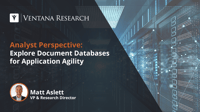The six costliest words in managing a finance department are, “we’ve always done it this way.” Closing the books is the process of finalizing and summarizing the financial activities of a business for a specific accounting period (typically a month, quarter, or fiscal year). It involves completing various tasks to ensure that all revenue, expense, and other financial transactions are properly recorded, accounts are balanced, and financial statements are prepared. Accounting processes are...
Read More
Topics:
Office of Finance,
ERP and Continuous Accounting,
digital finance,
AI & Machine Learning,
Revenue, Lease and Tax Accounting,
Consolidate/Close/Report
While I do not have an MBA, I have a very academic degree in economics and three decades of experience in different facets of business. Why is this important or relevant? Well, an entire industry has sprung up to promote the latest business ideas, the adoption of which will, supposedly, if not guarantee success, improve the probability of success in any endeavor. And while some of these ideas have merit, many fall in the “interesting but so what” category.
Read More
Topics:
Digital Commerce,
Office of Revenue
For decades, most organizations thought of onboarding as a basic housekeeping item, akin to filling out tax withholding paperwork, having a picture taken for a badge, getting a uniform or signing for a handbook. In reality, true onboarding encompasses much more. It’s considerably more strategic than tactical, including all processes required to successfully integrate a new employee into an organization.
Read More
Topics:
Human Capital Management,
Talent Management,
employee experience
I have previously written about the functional evolution and emerging use cases for NoSQL databases, a category of non-relational databases that first emerged 15 or so years ago and are now well established as potential alternatives to relational databases. NoSQL is a term used to describe a variety of databases that fall into four primary functional categories: key-value stores, wide-column stores, document-oriented databases and graph databases. Each is worthy of further exploration, which is...
Read More
Topics:
Data,
operational data platforms
Intelligent automation is a powerful tool that can help the CIO and IT leaders optimize business processes and outcomes while reducing costs, risks and errors. Automation takes many forms, each with its own applications, benefits and limitations. In a previous perspective, I shared how technology helps organizations automate processes and enhance workflow efficiency. This perspective explains the various types of automation enabled by artificial intelligence technologies and their applications...
Read More
Topics:
Digital Technology,
AI & Machine Learning,
robotic automation
As we celebrate the first half of what seems to be the year of generative artificial intelligence, with an apparently unlimited discussion of use cases and bogeymen, my attention is turning to the very mundane question of costs. Specifically, how costs incurred – through investment and operation – will be distributed along the value chain and how this will affect the demand for AI ‒ by whom and for what purpose. It’s a question that needs asking even though, at this stage in the market’s...
Read More
Topics:
Office of Finance,
Continuous Planning,
Business Planning,
Enterprise Resource Planning,
natural language processing,
digital finance,
AI & Machine Learning,
Consolidate/Close/Report,
Continuous Supply Chain & ERP
Automation uses technology to perform tasks or functions that would otherwise require human intervention or effort. Automation has existed for decades, and it takes many forms. It handles routine tasks, freeing time for knowledge workers to perform other activities that require creativity, subjectivity or empathy. Automation can also improve the quality, efficiency and consistency of business processes as well as enhance customer satisfaction and brand loyalty.
Read More
Topics:
Digital Technology,
AI & Machine Learning,
robotic automation
The publication of Ventana Research’s 2023 Operational Data Platforms Value Index earlier this year highlighted the importance of incorporating analytic processing into operational applications to deliver personalization and recommendations for workers, partners and customers. This importance is being accelerated by interest in generative AI, especially large language models. The emergence of intelligent applications has impacted the requirements for operational data platforms with the need to...
Read More
Topics:
Analytics,
Cloud Computing,
Data,
Digital Technology,
AI & Machine Learning,
Analytics & Data,
operational data platforms,
Analytic Data Platforms
Increasing threats and challenges from cyberattacks, data breaches and other incidents have made digital security a critical concern for organizations. These dangers have devastating consequences, including financial loss, reputational damage, legal liabilities and operational disruption. Adopting effective and efficient digital security strategies is key to protecting data, assets and customers from risk.
Read More
Topics:
Digital Business,
Digital Security
I recently attended Sage Software’s Partner Summit. Implementation partners account for most of the sales and implementation of finance and accounting applications designed for small and midsize businesses, so they are important to the success of the software vendor. These events are designed to inform partners of product enhancements and the product and technology roadmap as well as provide a perspective on market conditions and trends.
Read More
Topics:
Office of Finance,
Business Planning,
ERP and Continuous Accounting,
digital finance,
AI & Machine Learning,
Purchasing/Sourcing/Payments,
Consolidate/Close/Report
Perhaps no human capital management-related topic has been more widely examined in recent years than the struggle to find and retain top talent. Software has flooded the market to address the challenge from every angle — automated sourcing and stack ranking of candidates; artificial intelligence-powered employee sentiment analysis for identifying and reducing the risk of attrition; and internal skills gap identification with connected learning opportunities to help organizations quantify what...
Read More
Topics:
Human Capital Management,
Talent Management



















